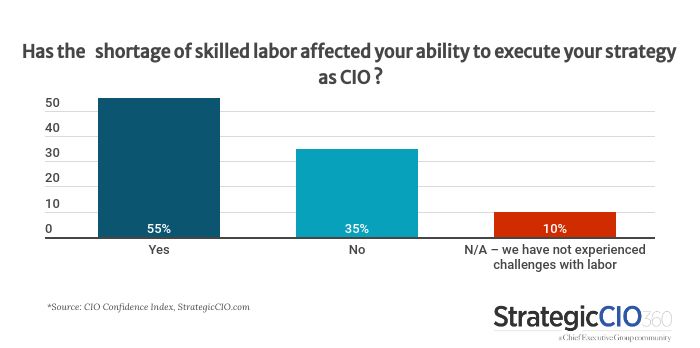Pandemic disruptions continue to dramatically impact the work of CIOs, from the rise in cyberattacks to the demands of a substantially remote workforce to supply chain issues to talent challenges, information and technology chiefs tell StrategicCIO360 in our November-December Confidence Index, a monthly flash poll of American CIOs’ outlooks for business.
Fifty-six percent of CIOs say that boosting their company’s cybersecurity defenses is one of their main priorities for the months ahead. Second to that, 40 percent of CIOs are planning to devote their time to enhancing their company’s CX/digital strategy and 36 percent will focus mainly on recruiting, developing and retaining specialized IT talent.
Remote/Hybrid Work Environment
Many of CIOs’ priorities flow from the shift to remote work, which has forced them to change their tech investment strategies. They say the switch has improved productivity and retention, but also increased challenges with their budgets and security. Overall, spending is up on remote devices and cloud-based apps.
The CIO at a public nonprofit says that the remote/hybrid environment has “caused us to speed up the digital transformation process and increase support requirements, while exacerbating cybersecurity risk.”
Gerald A. Edwards, CTO at The Sourcing Group, agrees that security issues have been exacerbated. “We were fairly well positioned prior to lockdowns,” he says. “However, security issues have arisen to the forefront of concern due to the highly distributed network we now support. This accelerated my move to the cloud of all apps.”
Daniel Black, SVP/CTO at InfoMc, a healthcare provider/payer, says, “Salaries are no longer regional, there has been a lot of flux in base salary requirements. The office phone system has not been utilized in over 1.5 years; changed to a virtual phone appliance. Also, moved all infrastructure out of the office to a colo facility for access to remote hands where necessary.”
Many have seen great improvements in their productivity and responsiveness. One VP and CIO at a tech company shares, “The remote environment is making our organization more responsive, agile and productive.”
The CIO of a healthcare company says, “We’ve been remote company-wide for 20 months and everyone loves it, technology holding up and overall productivity up 12% (sustained).”
Getting Support
Fortunately, the majority (51 percent) of CIOs say that their colleagues are very supportive and committed to the automation of business processes. Only 1 percent feel as though they are not supported.
“We are adopting a series of management tools for the business leaders to have better insight on at-home associates. The goal being to give the manager methods and tools to verify or monitor work efforts being truly delivered on by remote associates,” says the CTO of a financial services firm, explaining what new tech he is using to support the remote environment.
Others share that they have equipped all staff with personal tech such as laptops and are also leveraging existing technologies such as MFAs, VPNs and cloud services. Private social space software and presentation tools, along with additional training, are important as well. But upgrading their security software and implementing new training for employees are the most important steps CIOs are taking to support their hybrid and remote work.
Talent Concerns
Fifty-five percent of CIOs say that labor shortages are affecting their ability to execute their strategy as CIO. Only 10 percent say that they have not experienced challenges with labor. However, talent troubles have been top-of-mind for executives across the board. In recent polling by our sister publication, StrategicCFO360, CFOs predicted that current labor challenges won’t subside until the coming summer
Top among the CIO community’s response to the shortage is to emphasize retaining current employees.
“Focus on retention over recruitment, demonstrate tangible support for work/life balance, highlight unique opportunities in the position, what perks does your company bring to the table (real perks, not game rooms),” says the CIO at a nonprofit.
Employee development is also important.
“Internship programs, especially with a diversity focus, have proven to be very good feeder programs into our permanent staff. Hiring from known, great candidates,” says another nonprofit CIO.
Jeff Edlun, CTO and CTG of tech giant Hewlett Packard, says, “Create flexibility in work locations, hours and a highly engaged employee culture. It’s not about the job you are hiring for, it is about the career path you can provide.”
“Create an environment where associates want to be and can succeed. Build this around a mission and give people something greater to believe in than just the work they perform,” says the SVP of technology at a consumer manufacturing company.
The VP and CIO of a tech company urges his colleagues, “Let employees be remote. Offer competitive salaries. Create employment options for young families to make it a better place to raise your children. Offer education opportunities to your staff to recruit younger employees. Offer share work programs for older staff and mothers.”
Others encourage CIOs to look beyond current pools and expand globally. William Vance, CTO at Adams and Reese, says, “Create a pipeline of skill globally by hiring trainees. Build stronger vendor strategy to ensure they understand your needs ahead of time to plan better.”
“Leverage global resources. Everyone is working remote so why does it matter where they are located,” says the CTO of a nonprofit, describing his strategy to recruit additional skilled talent.
To receive a full report of the finding and to join our research panel and be notified of opportunities to participate in future surveys, please email Research@ChiefExecutive.com.
About the CIO Confidence Index
The CIO Confidence Index is a new monthly pulse survey of CIOs and technology chiefs on their perspective of how current events are affecting their companies and strategies. Every month, StrategicCIO360 surveys hundreds of CIOs across America, at organizations of all types and sizes, to compile our CIO Confidence Index data. The Index tracks confidence in current and future business environments, as well as their forecast for their company’s revenue, profit, cyber and tech investments, and IT staffing for the year ahead. Learn more at StrategicCIO360.com/CIO-Confidence-Index.









